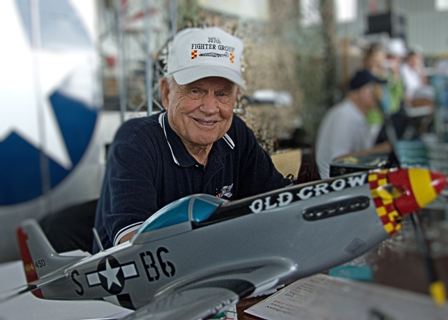
04 Mar Triple Ace, Single Purpose
I recently attended a lecture at the Smithsonian Air and Space Museum. It was one in the Charles A. Lindbergh Memorial Lecture series focusing on the spirit of flight. That evening one of the renowned members of the National Aviation Hall of Fame was to be honored. The honoree was Colonel Clarence E. “Bud” Anderson, a WWII triple ace fighter pilot who had flown 116 combat missions during the war and logged over 7,500 hours in more than 130 types of aircraft. His good friend, Chuck Yeager, described Anderson as “the best fighter pilot I’ve ever seen.”
Prior to accepting the award, Colonel Anderson, shared his exploits as a fighter pilot and provided us a lengthier presentation on his days as an Air Force test pilot and the director of flight testing during the Cold War.
I have to admit that I was not too familiar with the specifics of the Century series, F-86, F-105, and other fighter planes he mentioned. But I did not need to fully understand what these planes were or did to grasp the risky, life-defying battle missions or flight test programs he spearheaded. Listening to Anderson and watching the grainy video of in-flight testing runs from the late 1940s and early 1950s, I knew that this was a person who went to work each day not knowing how the day would play out, if success or failure was to be had. And in his case, Anderson’s failure could be disastrous, e.g. losing expensive planes, or it could very well mean his or a comrade’s death. But he also pointed out just how seemingly catastrophic failure could be averted by quick thinking, and that the review of what happened could be used as the next step to future success.
At one point, Anderson was asked why, after the thrill and achievements of the war, he agreed to be a test pilot. It couldn’t possibly have been nearly as interesting or exciting. His answer was simply that he wanted to fly and this seemed like a pretty good way to do that.
As I listened to him, I realized that Anderson’s life had been driven by a single passion and purpose, and also by a willingness to take any and all opportunities to see where they might lead if it meant that he could do what he loved. He assumed what risks there were, tried to avoid failures and basked in the triumphs, keeping both in mind as he went on to what was next.
Anderson is today 91 years old. He stopped flying solo just last year, but is still an instructor. I was amazed at his agility, physically and mentally. As he stood at the lecturn, he did have some moments when he couldn’t work the slides or he couldn’t hear a question. But what he didn’t show was any less enthusiasm for flying, his life’s work, than what I imagine he had 60 or 70 years ago. It was fun to listen to him because it was obvious that he was still having fun with flying.
I left the lecture with a powerful insight. We all should seek our purpose, see what opportunities there are to serve in that purpose, and strive to meet the opportunities. We should also recognize that there is both success and failure, but neither should cause us to divert from our purpose and finding yet more ways to serve in that purpose. If we do, maybe we’ll get to be quite a bit older, like Colonel Anderson, full of life and still having fun plying our trade!

MO BAILEY, MCC
Posted at 22:38h, 16 JulyHey Tassey, let me know when you want to arrive at the Charles Lindbergh airport (in San Diego) – good to have some face time again and we can do it over a cocktail or a coffee!